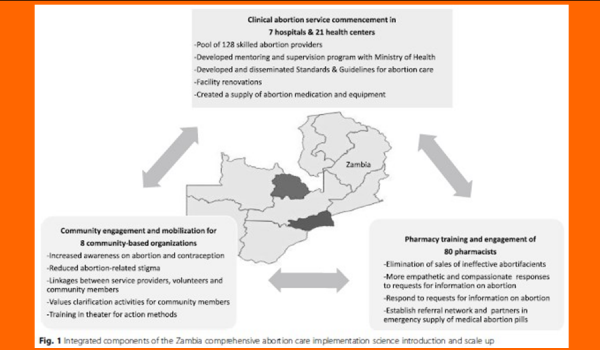
Tamara Fetters, Ghazaleh Samandari, Patrick Djemo, Bellington Vwallika, Stephen Mupeta
Reproductive Health, 16 February 2017 DOI: 10.1186/s12978-017-0289-2 Open Access
Background Although abortion is technically legal in Zambia, the reality is far more complicated. This study describes the process and results of galvanizing access to medical abortion where abortion has been legal for many years, but provision severely limited. It highlights the challenges and successes of scaling up abortion care using implementation science to document 2 years of implementation.
Methods An intervention between the Ministry of Health, University Teaching Hospital and the international organization Ipas, was established to introduce medical abortion and to address the lack of understanding and implementation of the country’s abortion law. An implementation science model was used to evaluate effectiveness and glean lessons for other countries about bringing safe and legal abortion services to scale. The intervention involved the provision of Comprehensive Abortion Care services in 28 public health facilities in Zambia for a 2 year period, August 2009 to September 2011. The study focused on three main areas: building health worker capacity in public facilities and introducing medical abortion, working with pharmacists to provide improved information on medical abortion, and community engagement and mobilization to increase knowledge of abortion services and rights through stronger health system and community partnerships.
Results After two years, 25 of 28 sites provided abortion services, caring for more than 13,000 women during the intervention. For the first time, abortion was decentralized, 19% of all abortion care was performed in health centres. At the end of the intervention, all providing facilities had managers supportive of continuing legal abortion services. When asked about the impact of medical abortion provision, a number of providers reported that medical abortion improved their ability to provide affordable safe abortion. In neighbouring pharmacies only 19% of mystery clients visiting them were offered misoprostol for purchase at baseline, this increased to 47% after the intervention. Despite progress in attitudes towards abortion clients, such as empathy, and improved community engagement, the evaluation revealed continuing stigma on both provider and client sides.
Conclusions These findings provide a case study of the medical abortion introduction in Zambia and offer important lessons for expanding safe and legal abortion access in similar settings across Africa



